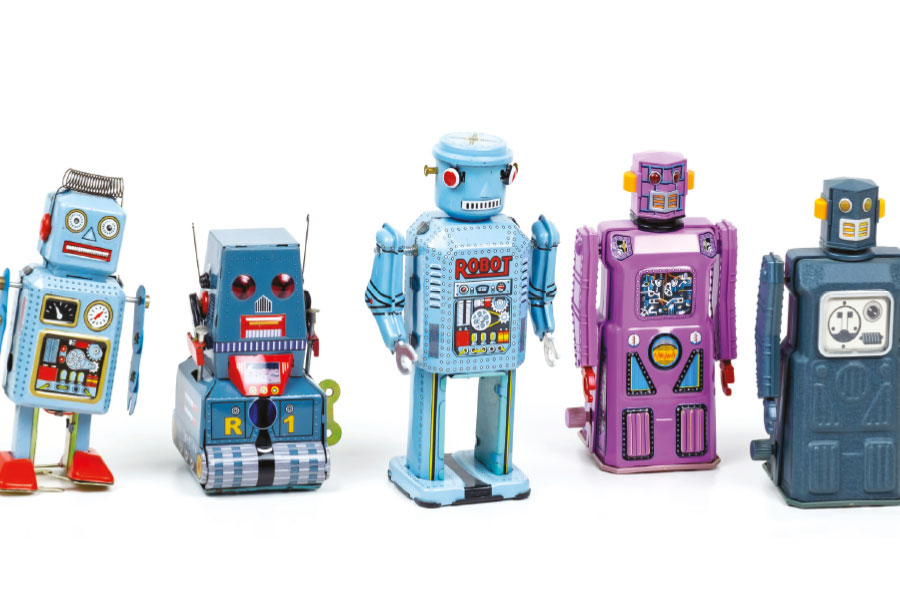The future is here – and while we may not be at Terminator 2 levels yet, it’s still worth floorlayers keeping an eye on developments. David Strydom explains.
MY first experience with a robot was in September last year at an unlikely venue: Kraków Airport in Poland. While settling down for breakfast before my flight back to the UK, a friendly, even cheerful, robot slid over and asked for my order. A few things quickly became apparent: the robot was quick, efficient and even quite charming.
And something else caught my attention: despite the restaurant being rather sizable, it was served – other than the robot – by only one waitress.
‘Is it going to take your job?’ I asked mischievously. The waitress chuckled. ‘Not yet,’ she said. ‘But soon.’ She told me that when the robot wasn’t operating for whatever reason, children were visibly disappointed at being served by a humble representative of homo sapiens. ‘They want the robot,’ she told me. One day in the not-too-distant future, I thought, they’ll have more robots than they’ll know what to do with, and maybe they’ll yearn for a simple human again.
Or maybe not.
I tell that story only to illustrate how close we are to the future we’ve been hearing about for decades. Terminator 2, with its sinister marriage of machine and human ingenuity, is a landmark cultural moment often referenced by those who warn about the coming of the machines. But now that moment is no longer decades or even years away – it’s literally here, waiting for the inevitable tipping point.
Of course, one can’t be a luddite about these things: robots may well herald a new medical dawn where human error during, for instance, medical operations, could be virtually eliminated. The good that can be achieved by robots is undeniable, which is precisely why the human race is running headlong into embracing them.
My experience was the least of it: I’m sure many readers have seen far more sophisticated technology. In fact, you only have to tune into a technology news programme to get a taste of what’s around the corner.
To wit: Boston Dynamics’ Atlas robot has stunned audiences by running parkour courses and even completing backflips, while NASA’s Perseverance rover not only drives itself across Martian terrain but has successfully produced oxygen from the planet’s atmosphere using the MOXIE experiment. In medicine, the da Vinci surgical system is now routinely used for precision operations, and in construction Australia’s Hadrian X has demonstrated the ability to lay up to 500 bricks per hour under ideal conditions.
Of course, it isn’t always so straightforward: Canada’s hitchhiking robot HitchBOT charmed travellers across two continents before being vandalised in the US, and Starship delivery robots in UK towns have gone viral for getting stuck in snow, blocking traffic, or facing technical malfunctions. Japan’s Henn-na Hotel, which once relied on 240 robots including dinosaur-shaped receptionists, had to reduce its robotic staff by about half after they annoyed guests and bungled basic tasks.
Nonetheless, the future has arrived, whether we like it or not. We may not be fully immersed in it yet – which would mean the average person walking around with brain implants and a pet robot to accompany us – but contextually we’re close enough.
The first big gamechanger for most of us, aside from Elon Musk’s work with Neuralink on brain implants, has been the inexorable rise of AI. Most of us see that as ChatGPT and its counterparts – Claude, Gemini, Grok, etc. And frankly, these interfaces present as much of a revolution as the introduction of the internet itself.
For the moment, the danger AI represents to employees is still emerging but the hazards are clear. For routine, rule-based, and data-processing tasks, such as data entry, basic customer service, bookkeeping, and telemarketing, employers are increasingly expanding their options to include AI.
Several big UK companies have fired a starting gun on the issue. BT expects AI to replace about 10,000 jobs as part of wider workforce cuts by 2030. Amazon’s CEO has acknowledged generative AI will mean fewer people are needed in certain roles. Klarna says AI already manages the work of hundreds of customer service agents, directly limiting recruitment.
In broadcasting, Sky has announced around 2,000 job cuts, with automation and online systems set to take over customer support functions. In retail, Ocado has confirmed 500 technology and finance roles will be cut, citing efficiency gains from AI.
Other roles in potential danger include content creation (writers, translators, and marketing content), some transportation and manufacturing jobs due to robotics and autonomous vehicles, and administrative functions such as receptionists and data processors, which may face significant disruption from AI-driven systems.
That may make those in manual jobs – such as floorlaying, construction, carpentry etc – breathe a sigh of relief. For the moment, their jobs are safe. But nobody should rest on their laurels because there are many risks just around the corner.
A cursory glance at the recent news will tell you robot bricklayers, for instance, are being looked at to fill labour shortage gaps and build new homes quickly. According to a report in The Telegraph, a London-based firm is trialling robots developed by a Dutch company, which use twin mechanical arms to dispense mortar and lay bricks at human-level speeds — about 500 bricks over an eight-hour shift.
The managing director of the London-based firm told The Telegraph the machines were being tested to see if they could be adapted to British standards and used on scaffolding. ‘We don’t think they’ll ever completely replace brickies, but they can certainly help with the skills shortages we’re dealing with,’ he said.
Robots which have already been used on dozens of projects in the Netherlands are expected to be priced at about £1 per brick — broadly in line with current market rates. They can also be programmed to produce complex patterns and multicolour designs without additional cost.
Meanwhile, other developers are trialling alternative systems, as reported on Fix Radio. As Construction Index reported, a Czech firm has deployed its ‘Walter’ robot to build 27 homes in Durham for a developer. Capable of laying up to 200sq m of masonry per day (as much as 10 times the human average) Walter can reportedly construct walls up to 3.5m high without scaffolding and in any weather.
The developer’s founder said the industry’s labour shortages come at a time when government housing targets are rising sharply. ‘There simply aren’t enough bricklayers entering the trade to keep up with demand for affordable homes, so we must find new solutions,’ he said. Robots, he added, could ease pressure on the sector while creating skilled roles for operators to oversee the technology.
So far, robot bricklayers have impressed – at least in controlled settings where they’ve proved faster than humans. The SAM100 lays about 300-400 bricks an hour and Australia’s Hadrian X capable of placing up to 1,000 per hour (for context, a skilled human bricklayer is capable of 75-150 an hour).
But although the benefits are there for all to see – speed, precision, and relief from labour shortages, especially on large projects, there are limitations: it still takes a long time to setup robots, which are hampered by complicated designs such as corners and arches. Importantly, they also require skilled workers to do quality checks. Then there are the costs.
Buying robots – and maintaining them – isn’t cheap. In the real world, weather, inconsistent ground and space constraints reduce robotic effectiveness. So, in the round, robots are still only supplementary tools for tradespeople – not replacements.
And yet…
The story we often tell ourselves is: why wouldn’t an employer choose a robot over a person? A robot may initially be costly, and it may require maintenance. It may also struggle to do every task a human does. But that will change in time. At that point, an employer might consider his options.
A robot won’t take days off sick, or require holiday, or need a pension contribution, or get offended by workplace culture, or take its boss to a tribunal. Faced with that choice, what would you do if you were an employer?
That day, for floorlayers, brickies and other tradespeople, will thankfully come far later than it will for data processors, bookkeepers, and editors. But it will come, and we’d be better be ready when it does.
David Strydom is editor of CFJ


